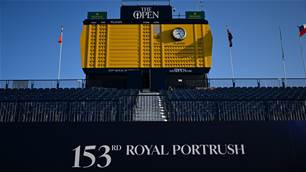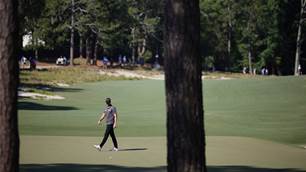It’s long been decreed by those dungeon masters of the United States Golf Association that U.S Open venues must have super-thin fairways and thick, chunky, chop-it-sideways rough. Thus, the first two times Pinehurst No.2 hosted the national championship (1999 and 2005), it was a beast more penal than Pentridge. Yet the USGA appears to have mellowed, and bucked the trend of punishment for the sake of it. And it’s been Pinehurst at the vanguard. And this year's U.S Open should be entertaining indeed.
TAMING THE HIMALAYAS
In 2014, Pinehurst No.2 hosted its third U.S Open, won by Martin Kaymer of Germany, who appeared to be playing a different course to everyone else when shooting 65-65-72-69 for nine-under. He would win by eight from Fowler and someone called Erik Compton, with Jason Day two back at the more U.S Open end-score of +1. Kaymer’s 271 remains the second-lowest U.S Open total after Rory McIlroy’s 268 at Congressional in 2011.
Today, Kaymer is in his last year of exemption and has a greater chance of winning Powerball, including the supplementary number, than he does of winning the U.S Open at Pinehurst No.2.
He did finish in a tie for 19th at LIV Singapore, before tying for 73rd at the PGA Championship. In his last start before returning to Pinehurst – LIV Houston – he had his best finish in years, T9. Although there are some signs of life, it would be a surprise if he featured in North Carolina this time around.
Yet we can draw something from Kaymer’s runaway win in ten years ago, according to our man Michel. “When he won, he was basically putting it from everywhere when he missed the green,” Michel says.

While one of Scottie Scheffler’s super powers is the best wedge game around the greens – and that will still be quite handy at No.2, as it is everywhere – Michel reckons the green surrounds could suit someone who doesn’t necessarily have the best wedge game.
Rather, if they can roll the rock from well off the green, can judge speed and pace up and over the humps and lumps, they could get up and down without needing super-delicate – call them “Scheffler-esque” – chip and pitch shots. Consider Collin Morikawa, a clean ball-striker in decent form. Might he attack flags confident that if the ball runs off he can just “two-putt” back up the hill should the ball roll off?
Michel reckons the greens will play faster than they might read on a Stimpmeter. “They’re going to be in that 11-12 range, but probably not crazy. With the amount of flow on some of the greens, they’re probably not going to be that quick. I think they play faster because of the tilt on a few of them,” Michel says.
“They [USGA] probably don’t want too much of that. They like a bit of carnage; they like them fairly fast. But I don’t think they’ll get crazy.”

Still, there’s a little bit about them. They are bad-ass greens. They will suit a bad-ass player.
Brooks Koepka is that player.
THE TIP
If we had a copy of a 2030 issue of Gray’s Sport Almanac from Back To The Future, it would, presumably, show Scottie Scheffler lifting the 2024 U.S Open Championship trophy at Pinehurst No.2. But time travel is yet to be invented and the big, bad Biff Tannen of world pro golf is five-time major champion Brooks Koepka. He can get better – or at least maintains a status quo, which in a U.S Open can be as good – while everyone else fights in the hurt locker.
Notable two-time champions of the U.S Open include Walter Hagen, Gene Sarazen, Lee Trevino, Ernie Els and Koepka. Were Koepka to win again, he would join Tiger Woods who won in 2000, 2002 and 2008, the last time with a bung knee and following a putt for the ages which got him into a play-off with Rocco Mediate.
Koepka has also won the U.S Open mini-me, the PGA Championship, three times, in 2018, 2019 and 2023 when he posted -9 to win by two from Scheffler and Viktor Hovland, with Bryson DeChambeau, Kurt Kitayama and Australia’s Cam Davis four shots further back.
In U.S Opens, a lot of players make good, even great pars. There are good bogies. Doubles, not so much. And triples, you want to avoid those. When it comes down to a grind of mental strength, when you need to muscle it out of a thick rye tuffet, that’s where Koepka, chippy and strong, can raise his game, powered by the knowledge that if he’s battling, then the college boys in their lettered cardigans are being waterboarded. These thoughts amuse him. They are his breakfast.
He might need to poison Scheffler’s scrambled eggs, however.
NOBODY’S FAVOURITE FAVE
Scottie Scheffler has the all-round golf game to suit Pinehurst No.2 for a U.S Open as he does everywhere, certainly in the United States. And, like Dustin Johnson before him, mentally it doesn’t appear there’s a lot going on. Nothing extraneous. Just the knowledge that his wins have been pre-ordained by Jesus.
The usual litany of suspects will line up to challenge Scheffler. Pick a top-10 LIV player or a top-25 OWGR one, and you can make a case why it’s their turn to sneak up the leaderboard to bite Scheffler’s ankle. Bryson DeChambeau, Max Homa, Lucas Aberg had their moments at Augusta. Xander Schauffele, he got the monkey off his back at Valhalla.
But they’re all chasing the preternatural ball-striking of Scheffler. The man’s owned golf in 2024, made the very hard look perfunctory. He is subjugating the game, killing contests. He is approaching Tiger Woods or Nelly Korda levels of dominance. And he’s so good and so free of charismas, he’s slaughtering golf as a spectacle, as spectacular as his iron-play is.
And you wonder: for such an apparently harmless, gormless, God-fearing, ‘nice’ American fellow cast from the same cookie-cutter of lanky, tall, all-American Gomer Pyle-style players as Matt Kuchar, Keegan Bradley, Tony Finau, and all the rest, has there been a U.S Open favourite death-ridden so hard by so many?
AUSSIES, AUSSIES, AUSSIES
David Graham won Australia’s first U.S Open in 1981, at Merion GC in Pennsylvania, closing with a brilliant 67. Geoff Ogilvy won Australia’s second U.S Open trophy in 2006 at Winged Foot, chipping in on the last and watching Colin Montgomerie and Phil Mickelson blunder their way up 18.
Since then, Jason Day has been our brightest light. He was second in 2011, eight shots behind Rory McIlroy. He was second again in 2013, two shots behind Justin Rose. He was T4 behind Martin Kaymer in 2014 and was co-leader after three rounds at Chambers Bay in 2015, when Jordan Spieth won and a young kid called Cameron Smith finished two off the pace with Adam Scott.

There are reasons for Aussie optimism in 2024. Last year Smith was fourth, four shots from Wyndham Clark, while Min Woo Lee was a shot back in T5. Smith, Lee and Cameron Davis had pretty decent showings in hugely testing conditions at Augusta National.
And this: if there is a course setup that most reflects the Melbourne Sandbelt, it’s Pinehurst No.2. Even aesthetically, with the exposed sand, the native grasses and trees. The run-offs and tight surrounds will give Smith opportunity to roll the rock, as he did with great effect on the 18th at St Andrews to win the 2022 Open Championship.
The weather in June in the Carolinas will likely be mid-30s and humid. Call it Sydney or Brisbane summer. Excellent playing conditions. If the rain stays away, No.2 can get fast and firm. And if it’s windy and warm, it could be as brutal as Augusta was. For good players, wind is the great leveller. Aussies know wind. Aussies know firm and fast.
Smith’s driver wasn’t an all-snapping snake in Adelaide; there were few signs of John Daly’s extended chicken-wing on the way back. Smith has been working on a move with coach Grant Field since he was rolled out of Royal Queensland in November’s Australian PGA. He wasn’t perfect in Adelaide, but he bombed plenty straight.
And on the par-4s, long or short, even without driver he could employ 250-yard 3-iron or hybrid, followed by a short iron, and do his (world’s) best with 15- and 20-foot putts on bulbous, whale-back greens.
OLD TIGER
As Adam Scott arranges his schedule around the majors, so too does Tiger Woods, though Woods’ body doesn’t allow him to practise much, much less play 72 holes of golf in lead-up competition. And as his two competitive rounds at Augusta National, and the two in which he shot 15-over, showed, the man remains a work in quite slow progress.
Is it over? They’re lining up to tell you it is. That his body has failed him and will continue to. Tiger, though, and one assumes he’s had advice from some of the great orthopaedic minds of our time, believes his body has the capacity to heal and that if he keeps working out, he’ll be match-fit eventually.

After the Masters, Woods said: “I’ll just keep lifting, keep the motor going, keep the body moving, keep getting stronger, keep progressing. Hopefully the practice sessions will keep getting longer.”
RIGHT: Is it over for Tiger? They are lining up to tell you it is. That his body has failed him and will continue to. PHOTO: Getty Images.
Pinehurst No.2 is nearly 7,000m long; let’s assume he has to walk 10km a day and do that four days in a row. As he showed at Augusta, it’s do-able, even if his golf likely won’t get better the further he walks.
And if he can’t practise much, and he can’t play tune-up tournaments, and Sundays mean hobbling out of bed, then you begin to wonder, despite all the glad tidings people are throwing his way, and his own super-positive mindset, what is the actual point?
OLD DAYS
The U.S Open tournament has been beating up the world’s best players for 124 years.
In 1978 at Cherry Hills, Seve Ballesteros was so dispirited post-round, he was in no mood for quips with reporters. Asked to talk the press pack through a four-putt, Ballesteros said: “I miss, I miss, I miss, I get.”
In 1980 at Baltusrol, Ballesteros shot 75 in round one. On the Friday morning, he was stuck in traffic, missed his tee-time and was disqualified. “It doesn’t matter,” he told media. “I couldn’t win here anyway. The rough is too severe.”
In 1979 at Inverness, Jack Nicklaus three-putted five times in his first seven holes on the Friday – and still made the cut, which was +9. Tom Watson couldn’t hit a fairway – and missed the cut. So did Ray Floyd, Johnny Miller, winner of that year’s U.S Masters, Fuzzy Zoeller, and winner of the first Australian Masters, Gene “The Machine” Littler.

It is 40 years now since the great scribe Dan Jenkins wrote of the 1984 U.S Open in Sports Illustrated: “The Great White Shark, Greg Norman, played the last three holes by way of his native Australia, but somehow made three pars at Winged Foot in New York and forced the 18-hole play-off.”
Zoeller, with whom Norman would spend the Monday, was in the group behind Norman. When the Shark hit his six-iron on 18 into the grandstand, chipped onto the green and holed a 45-foot par putt to share the lead, the American, waiting back on the 18th fairway, took a white towel from his bag and waved it around his head in jest.
There would be no surrender, of course. Zoeller made a tough par look easy, and after 72 holes of the U.S Open, Norman and he were tied on four-under, five ahead of Curtis Strange and a leaderboard featuring Miller, Jim Thorpe, Hale Irwin (who was in that final group but about to post 79), Peter Jacobsen, Mark O’Meara, Fred Couples and Lee Trevino.
The pair came back the next day for 18 holes. Norman three-putted three times in the first five holes and shot 75, while Zoeller made 67, cracking gags all the way, and won by eight shots.
Related Articles

The Open Preview: Back Again

Opinion: Absolute mayhem at a U.S Open is long gone, so get on with it













